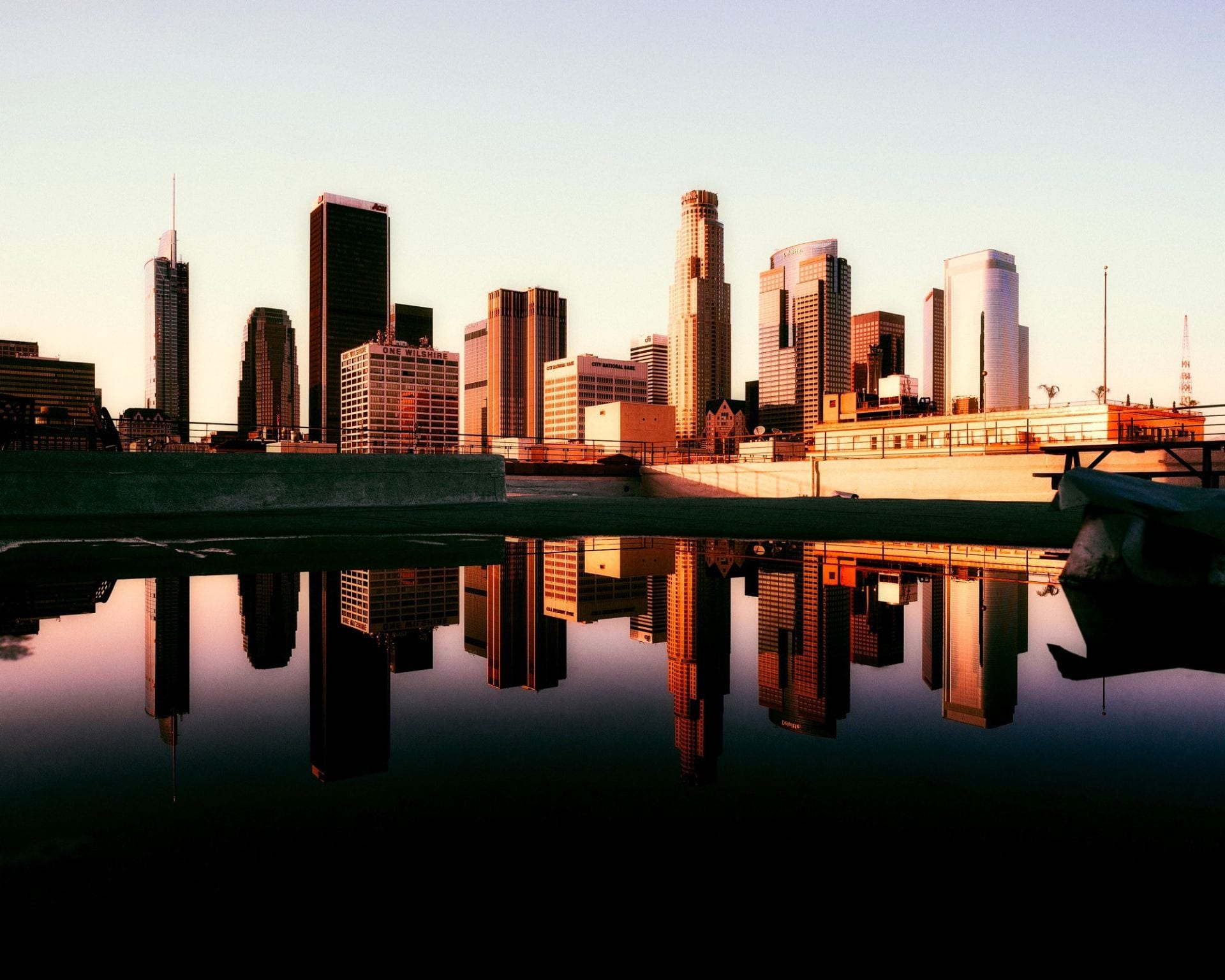
On the last day of the Baker Program’s domestic trek, students stayed close to their hotel in downtown Los Angeles to get a walking perspective on some of the projects beginning to reshape the landscape of the sprawling metropolis. Downtown Los Angeles has historically been overlooked in terms of livability. Over the last five years, however, a significant amount of capital has been invested in the downtown area as the real estate landscape changes to meet the live/work/play demands of new generations of workers. The first stop of the day was a site tour led by Robert Lathan, a senior associate at MacFarlane Partners and a 2017 graduate of the Baker Program.
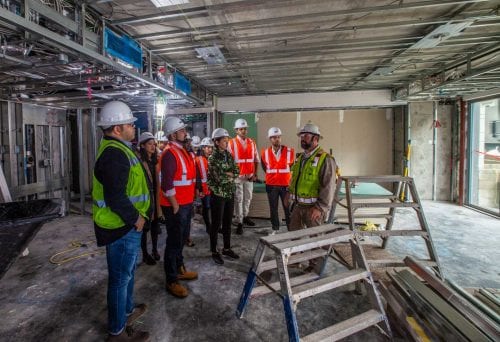
MacFarlane Partners is in the midst of a $300 million development directly across from Pershing Square. The project consists of two separate but linked buildings. Park Fifth, a 24-story high-rise, will contain 347 rental apartments and 5,300 square feet of retail space. Directly adjacent is the Trademark, a seven-story mid-rise development that will house 313 rental apartments and 7,500 square feet of retail space. With the project scheduled for completion in the coming months, students walked through the sites with the superintendent, learning about the challenges of the project and getting an opportunity to view in-progress unit construction as well as several recently finished units. Lathan also gathered the students in the site’s construction office to discuss the project and its complex capital stacks.
Once open, the units at both Park Fifth and the Trademark will seek to meet the growing demand within the Downtown Los Angeles market for luxury apartments. Young professionals continually seek to live closer to work and take advantage of a growing list of bars and restaurants that are beginning to populate the area. While both buildings will house significant amenities, Park Fifth will include a 360-degree-view rooftop deck with an infinity-edge pool and cabanas, a fitness center, and a clubhouse with a bar and kitchen. Ample seating with TVs as well as a business center will compliment the onsite resident concierge services and dog walking and wash stations.
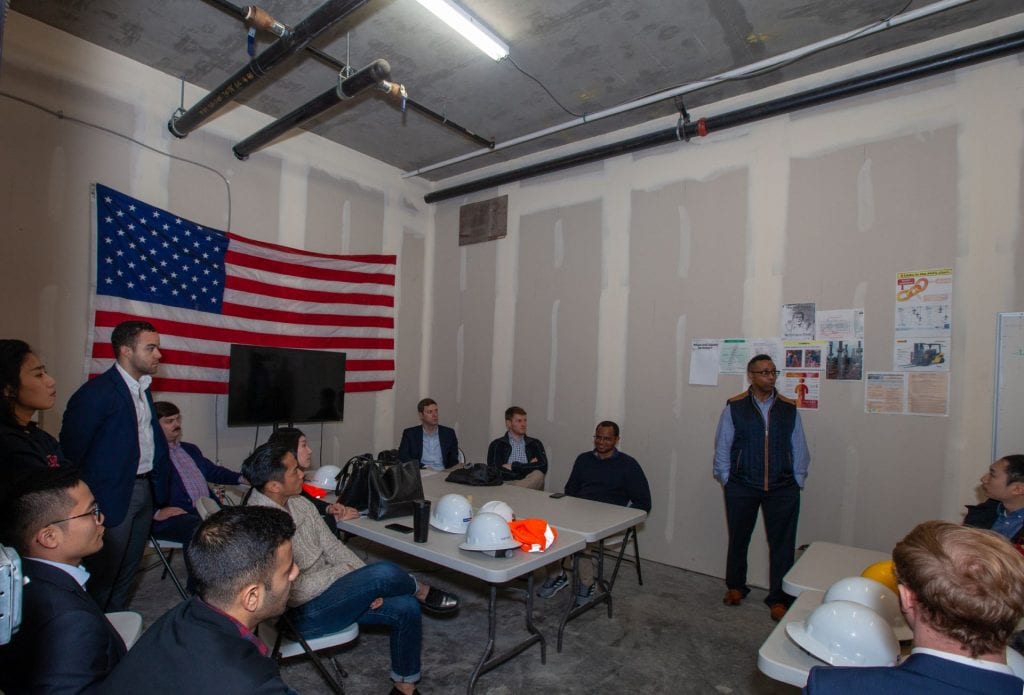
The second stop of the day was the global headquarters of CBRE. Students met with Khari Buck, Director of Workplace Transformations at CBRE and a 2011 graduate of the Baker Program, and Lewis Horne, CBRE’s Divisional President for the Pacific Southwest including Southern California, Hawaii and Arizona. In addition to learning how CBRE remained at the forefront of the real estate services industry, students were also able to tour the office itself, which is a showcase of alternative workplace strategy and the latest technology.
Horne explained CBRE’s current focus with a presentation on the “Year of the H”. The six H’s were a) Historic core, to signify the resurgence of downtown redevelopment as location drivers give way to ‘personality’ drivers, and with it a demand for adaptive reuse; b) Hong Kong, a signifier of global capital, with LA itself attracting $25 billion annually; c) High tech, a basic necessity in development today as the world moves towards models of being address-free and paperless, propelled by cloud storage; d) Hulu, an indication of on-demand content creation, with 20,000 FAANG[1]-style organizations densely packed in the Los Angeles metropolitan area; e) Hollywood Park, a connotation of the importance of sports entertainment in today’s culture with LA itself hosting close to 500 games a year even before the 2026 FIFA World Cup and the 2028 Olympics; and f) Homelessness, an issue that is dire across the country but especially in Los Angeles and must be the focus of directed conversation.

These trends are an indication of the direction the real estate industry is moving. Some of the additional trends that the group discussed at length were that of “experiential everything”, with a focus on the growing millennial population, but also a smaller and well curated retail sector; exploiting efficiencies of technology in offices; and a larger but more urban industrial sector. While shared office and homes are commonplace today, it was interesting to note CBRE’s take on shared industrial being the way of the future for that sector as well.
Another highlight of the visit was touring CBRE’s office, which is the world’s first WELL Certified Office. When designing this office, CBRE focused on every aspect of the health and wellness of the occupiers. In this case the company’s own employees are the center of attention. Starting with problem areas inherent in assigned space, with little room for growth, but at the same time having underutilized space, with inadequate technology and its ineffective usage, the Workplace Development division focused on not just creating an effective space but in taking leadership in office standards such that it created excitement not just in the users, but eventually the industry. Areas of attention included optimizing air quality through both mechanized means and biophilic plants, maximizing natural sunlight with circadian lighting to complement natural cycles, and focusing on ergonomics down to the detail of the cork flooring for lumbar support. All together the retrofit covered 50 technologies for biological sustainability.
The office was also developed as a completely shared space with on-demand usage, completely paperless as a result. A testament to its success was the speed at which users could reconnect hours after a major pipe burst without any hinderance to daily operations. As a result, the office became a model for resilience as the new offices were more organized, mobile and collaborative. This has become part of CBRE’s push to move from being a global leader in the real estate industry to all industries. This push to develop the space as “one’s extended body” led to almost 100% user approval with employees feeling as if they were never “at work.” We congratulate CBRE for this accomplishment, and thank both Khari Buck and Lewis Horne for their shared expertise.
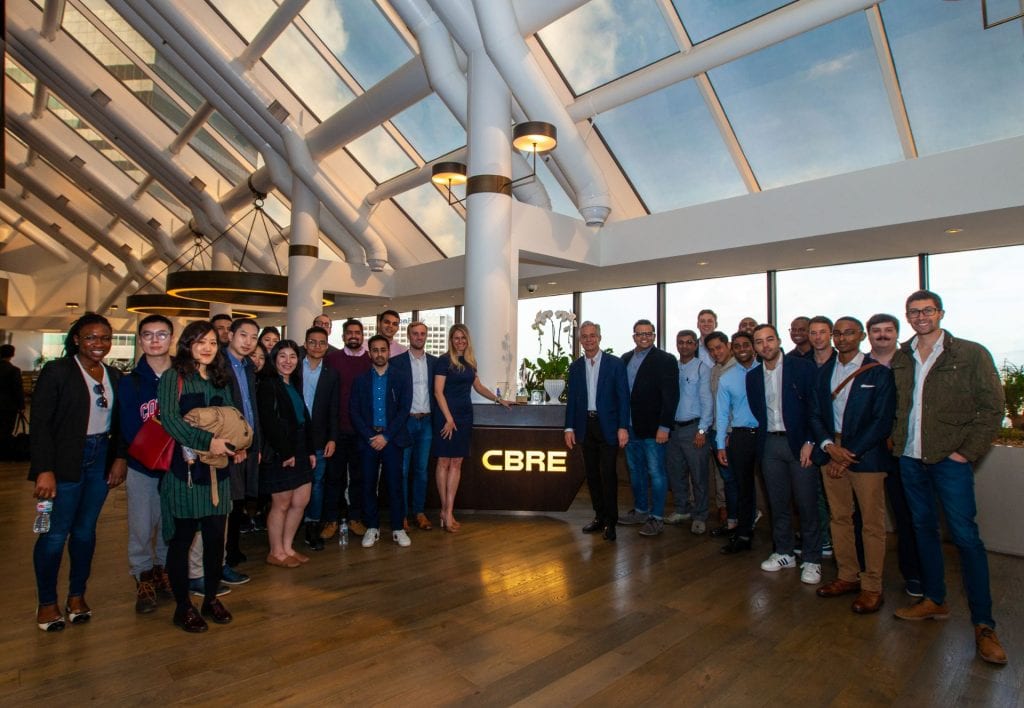
The final stop for Baker Program students was the offices of Related California in downtown Los Angeles. Related California is an affiliate of The Related Companies, L.P., a privately-owned real estate firm headquartered in New York City. The company is well-known for its sprawling Hudson Yards development, which is currently underway on the west side of Manhattan and is the largest private real estate development in the history of the United States. On the West Coast, Related California has completed more than 15,000 residences with another 5,000 in its pipeline.
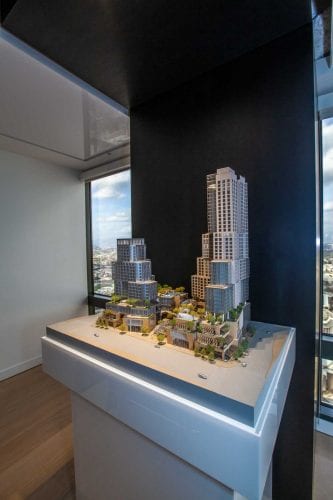
The company’s office provides incredible views of the Los Angeles area and of the development site for The Grand, a $1 billion+ mixed-use development being undertaken by Related California that, upon completion, will include a 39-story residential tower, a 20-story hotel tower, a podium with 27,000 square feet of retail space, a public plaza, and underground parking. Students were greeted by Steven Oh, Senior Vice President for Development, and Tyler Bibbins, Development Associate, who described Related California’s fourteen-year journey to bring The Grand to fruition. The project was designed by famed architect Frank Gehry and is located immediately across from the Walt Disney Concert Hall, which was also designed by Gehry, and is adjacent to other cultural and civic Los Angeles landmarks, including The Broad Contemporary Art Museum, the Civic Center, The Colburn School, and the Museum of Contemporary Art.
The residential component of the project includes a total of 436 apartments. Of these, 323 will be luxury apartments and 113 will be ultra-premium apartments designed to compete with Ten Thousand near Beverly Hills. The hotel component of the project will consist of a 309-room Equinox Hotel. Related purchased Equinox, the upscale gym company, and is launching a new luxury hospitality brand around the marque, with the first Equinox Hotel to be located in Related’s Hudson Yards project.
With Deutsche Bank providing $600M+ in construction financing in late 2018, construction at the site only recently commenced after more than a decade of delays due to the complexity of the project. Oh and Bibbins described how development and stabilization of this large project will take another several years and that, once completed, The Grand will be a strategic addition to Los Angeles’s booming downtown market.
The third day of the Baker Program’s domestic trek was instrumental in understanding downtown redevelopment in one of the most important gateway cities in the U.S. The students were grateful for the opportunities facilitated by the many alumni and benefactors of the program and of Cornell University.
[1] Facebook, Amazon, Apple, Netflix, and Google

